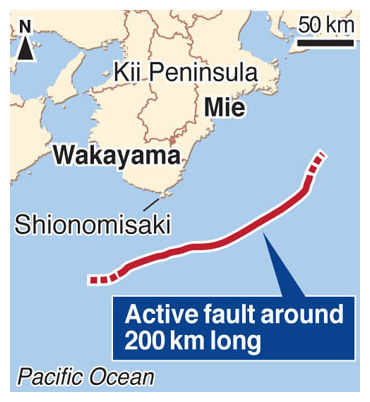
© Kyodo Graphic
Kyodo - An active fault around 200 km long that is believed to have been a source of huge quakes in the past has been found off Honshu's Kii Peninsula, according to researchers at the University of Tokyo.
If the fault on the Nankai Trough moves, it could trigger a magnitude 8.0 earthquake, the researchers said, adding they have found a seabed cliff several hundred meters high that was created by the fault's past movements.
"There is a high probability that fault shifts have caused great tsunami," said Park Jin Oh, associate professor of marine geology. "We need to reformulate disaster countermeasures by taking into account an active fault on the seabed 200 km or longer."
Park analyzed sonar data on the seabed collected by the Japan Agency for Marine-Earth Science and Technology and found a fault branching off from a boundary between two tectonic plates in an area west of the southern tip of the Kii Peninsula in Wakayama Prefecture.
The fault was found to be connected to a similar fault to the east of the peninsula and to extend at least 200 km, the researchers said.
While it remains unclear exactly when or how many times the fault has moved, the eastern and western parts are believed to have shifted often and at the same time, judging from the geographical characteristics of the area.
Such movements may have caused the 8.6-magnitude Hoei earthquake in 1707, Park said.
The eastern part of the fault is meanwhile believed to have caused a magnitude 7.9 quake and tsunami that struck in 1944.
In addition, an extended area of the newly discovered western part overlaps the area where a magnitude 8.0 quake struck in 1946. It is therefore possible that the western part moved two years after the eastern part did, Park said.
34% hoofed it after quakeSome 34 percent of people walked home from their workplaces or schools in Tokyo's 23 wards after the March 11 earthquake without waiting for train and other public transportation services to resume, a survey by the Railway Technical Research Institute showed Saturday.
For those who walked, it took an average three hours and nine minutes to get home, excluding time for breaks, the survey said They walked an average distance of 13.4 km, with 11 respondents walking more than 30 km.
The survey, which covered 960 people aged 16 and older who were in the 23 wards when the quake occurred, also showed that 47 percent headed home by train after services resumed, while 14 percent used buses or taxis. The remaining 5 percent went to accommodation facilities or stayed with acquaintances.
"More people preferred to walk home as the quake occurred in the early afternoon . . . and as the following day was Saturday," Masai Muto, a senior official at the institute said.
On March 11, East Japan Railway Co. said at around 6:20 p.m. it would halt all its train services in the metropolitan area following the 2:46 p.m. quake, but some subway lines resumed operations after 8:40 p.m.

Reader Comments
to our Newsletter